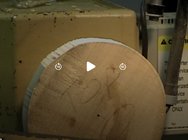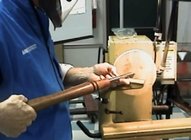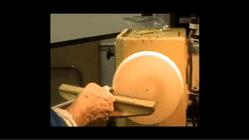To practice push, pull, and scrape cuts, I want to use less expensive but readily available kiln dried wood. Would the following work? A 2x8 pine stud cut into 8” lengths and sawn round on the bandsaw; an 80” long board giving me 10 cheap practice blanks. A concern I would guess would be grain orientation; what should I look for there, or will a very sharp edge negate that concern?
-
December 2025 Turning Challenge: Single Tree! (click here for details) -
Congratulations to Bob Henrickson, People's Choice in the November 2025 Turning Challenge (click here for details) -
Congratulations to Dave Roberts for "Low Rider" being selected as Turning of the Week for December 1, 2025 (click here for details) -
Welcome new registering member. Your username must be your real First and Last name (for example: John Doe). "Screen names" and "handles" are not allowed and your registration will be deleted if you don't use your real name. Also, do not use all caps nor all lower case.
You are using an out of date browser. It may not display this or other websites correctly.
You should upgrade or use an alternative browser.
You should upgrade or use an alternative browser.
Looking for Cost Effective Practice Wood Ideas
- Thread starter Lewis Elliott
- Start date
My educated guess is there are several turners within an hour of you who have dry/stabilized but small once turned bowls/platters they'd give you. I probably have ten myself lying around. Fairfield, CT is 3+ hour drive for you however. In terms of size I'd say most available will be or 7 to 9 inches in diameter or the smallest core from a large bowl.
PM me if you want to discuss shipping as an alternative.
Well, firewood is usually available for just picking it up if you know where to look. Some cities have log dumps. Any arborist will have stuff that they have to haul to the dump. Even firewood companies will have stuff they don't want to mess with. Any sawmill will have off cuts that can be great for bowl stock. You will need a chainsaw to process some of it. Green wood is far easier to turn than kiln dried wood.
robo hippy
robo hippy
- Joined
- Apr 27, 2004
- Messages
- 9,301
- Likes
- 6,056
- Location
- Lakeland, Florida
- Website
- www.hockenberywoodturning.com
What we use for practice wood is small green cut logs.To practice push, pull, and scrape cuts, I want to use less expensive but readily available kiln dried wood. Would the following work? A 2x8 pine stud cut into 8” lengths and sawn round on the bandsaw; an 80” long board giving me 10 cheap practice blanks. A concern I would guess would be grain orientation; what should I look for there, or will a very sharp edge negate that concern?
Tree trimmings can be big enough.
Firewood that hasn’t split too much will work well to
Certainly any construction lumber will work and because of its softness be more demanding that you keep the bevel floating over the wood as you cut.
If you have a lumber mill anywhere close they oftentimes have scrap bins.
Ours has two 1 for dumpster divers which sometimes has a few nice pieces in there and one with consistently good wood where they charge by the Pound
If you can connect with a local club, most turners have extra wood that needs a new home.
I still use construction lumber for practice, but only spindle orientation - if you can make a fine finial in that stuff, other woods are a breeze.
For bowl cut practice, bark on “green” logs (doesnt have to be fresh, just not dried out and cracked). Get a chainsaw if you dont have one (I have a 16” craftsman electric I use inside the shop, $80 a few years ago, gas one for outside). After I started looking for logs they became readily available from many sources. Chainsaw can cut blanks close enough, I dont use a bandsaw for them. Free logs etc are my sole source for turning wood - I dont buy blanks.
For bowl cut practice, bark on “green” logs (doesnt have to be fresh, just not dried out and cracked). Get a chainsaw if you dont have one (I have a 16” craftsman electric I use inside the shop, $80 a few years ago, gas one for outside). After I started looking for logs they became readily available from many sources. Chainsaw can cut blanks close enough, I dont use a bandsaw for them. Free logs etc are my sole source for turning wood - I dont buy blanks.
You can practice with construction lumber without cutting it round, just cut it into a square, you can always cut the corners off on a saw to speed up the process of getting it round. If you mount the 8" x 8" piece of pine on a face plate you can start cutting it round on the flat face and avoid trying
to cut the 4 corners off with a roughing gouge which will usually not work. If you cut the 4-corners off and start with an octagon you can usually use a roughing gouge and turn it round from the edge without chunks of wood tearing out. If I have a large "square" on a face plate I can use a parting tool
to cut a round slot into the face of the board and approach it from the front side and the back side of the board to get it round. I will stop the lathe right before it cuts loose and break the pieces off of the square blank.
to cut the 4 corners off with a roughing gouge which will usually not work. If you cut the 4-corners off and start with an octagon you can usually use a roughing gouge and turn it round from the edge without chunks of wood tearing out. If I have a large "square" on a face plate I can use a parting tool
to cut a round slot into the face of the board and approach it from the front side and the back side of the board to get it round. I will stop the lathe right before it cuts loose and break the pieces off of the square blank.
Please ... don't use a spindle roughing gouge on face grain. Use a bowl gouge.
- Joined
- Apr 27, 2004
- Messages
- 9,301
- Likes
- 6,056
- Location
- Lakeland, Florida
- Website
- www.hockenberywoodturning.com
Instead of cutting up framing lumber, I think your better practice would come from green logs. Check with local tree service companies or watch for utility/municipal crews removing trees. Green wood is a joy to cut and probably easier on your hands, tools, and lungs.
.
If you really are stuck on kiln dried, check with local lumber mills. We have a smaller place here that specializes in sawing up and drying local hardwoods and just inside their door is a big scrap bin of cut offs. A place that does doors and other millwork might have some pieces as well. Poplar would be a better choice than framing lumber.
.
If you really are stuck on kiln dried, check with local lumber mills. We have a smaller place here that specializes in sawing up and drying local hardwoods and just inside their door is a big scrap bin of cut offs. A place that does doors and other millwork might have some pieces as well. Poplar would be a better choice than framing lumber.
You can also check custom cabinet shops. If they use solid wood for anything, they can have very nice scrap bins.
robo hippy
robo hippy
Lewis,To practice push, pull, and scrape cuts, I want to use less expensive but readily available kiln dried wood. Would the following work? A 2x8 pine stud cut into 8” lengths and sawn round on the bandsaw; an 80” long board giving me 10 cheap practice blanks. A concern I would guess would be grain orientation; what should I look for there, or will a very sharp edge negate that concern?
I always practice and use scrap wood. Keeping a sharp edge is key. Working on a project that takes longer I sharpen the tools as I work on it. In addition, a sharpe tool keeps you from making errors. I notice that I become more "pushy" with my tools as the tools get dull, and than I take more chances, and ... than I make more errors.
With regard to grain orientation, it is a great way to practice scrape cuts, holding the tool in different ways, use different tools etc. The fibers of a pine stud are pretty soft and long, so you will see a big different between a nice sideways cut at a 45 angle compared to a scraping cut.
I receive cheap wood from neighbours and sometimes find wood dumpster-diving when I walk my dog. And some of the big suprises are the beautiful pattern you get from a scrap piece !
It is all about practicing, and going through all kind of wood allows you to experience the different woods.
Keep turning, make dust and have fun, stay safe!
Reto
Tom Gall
TOTW Team
A better approach.Keep turning, makedustshavings and have fun, stay safe!
Reto
yup, better to cut (shavings) than to sand (dust)A better approach.
Look for a local club to join. At our club a few of the guys core out larger bowls and bring in the cores to sell. They donate them to the club and the club sells them for $5.



